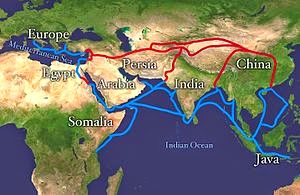
The pink part marks the steppes. The red lines mark the borders of "Europe," which is, obviously, not really a continent, but whatever we happen to feel like calling "Europe." Same goes, of course, for "Asia." Interestingly, a rather large % of Europe is steppe, though you don't hear much about it except in the context of "barbarian hoards boiling out of the steppe and threatening the walls of Europe," as though Europe started where the steppes end. Rather, the steppes lead right into the heart of Europe, like taking the Eurostar from France to London.
Physically, the steppes are largely flat and grassy. People have moved across them, often on horseback, for thousands of years. Much of the world's population is at least partially descended from steppe folks. 1 in 200 people today are thought to be descendents of the steppes' most famous warrior, Genghis Khan (and his immediate family, most likely.)
This post is mostly a random assortment of information I happen to have recently come across about various steppe peoples. I don't claim to be complete, extensive, authoritative, or even in chronological order. There are probably many large groups about which I know virtually nothing, and small groups about which I know comparatively a great deal.
One thing I noticed while looking at this first map is that the fabled (but very real) Silk Roads of Asia run well to the south of the steppes:
The Silk Roads (water routes excluded) go through some very rough terrain, like mountains and deserts. The steppes, while often cold, are nothing if not flat and easy to cross. Their under-utilization as a trade highway has probably been due to most of the goods people wanted to trade for coming from areas well to the south of the steppes, like the Iranian, Harappan, and Chinese civilizations. The steppes are not particularly known for their small, easily transported, valuable trade goods. This is not to say that trade did not cross the steppes, only that the steppes and the Silk Road are different.
Here's another fun map, of the Great Wall of China:
China has had, shall we say, an historical issue with getting invaded by the Mongols. I don't know if the walls particularly worked, but they certainly tried. (Those medium-purple wall sections up in the north were built by Chinese dynasties that were, apparently, ruled by Mongolian tribes from up that way. I'm not sure how that all works out in the nationalist rhetoric, if they should be properly considered part of the Great Wall complex, or an inter-Mongol defensive work, but they all do serve the same purpose.)
A map of Eurasia before the mongol conquest:
Another map of roughly the same period (they disagree on some points):
And after the Mongol conquest:
A lot of people died in between those maps.
Somewhere around 1280, a fellow named Rabban Bar Sauma, a Nestorian Christian born near Beijing to a perhaps Turkic or Uighir family, became an ambassador for the Mongol Empire and eventually made it to the Atlantic coat of France before heading back:
The parallel to Marco Polo is obvious, and indeed, he wrote a boo about his adventures, titled "The Monks of Kublai Khan, Emperor of China" or "The History of the Life and Travels of Rabban Sawma, Envoy and Plenipotentiary of the Mongol Khans to the Kings of Europe, and Markos Who as Mar Yahbh-Allaha III Became Patriarch of the Church of the East in Asia," which was translated by Sir E. A. Wallis Budge and published in English 1928... which means it might be in the public domain, depending on technicalities. Anyway, the Khan of the Mongols, Arghun, wanted to arrange an alliance with the French to conquer the Middle East together. Here's an excerpt of one of the letters he sent, which happens to mention Rabban:
According to the Wikipedia, the letter says,
"Under the power of the eternal sky, the message of the great king, Arghun, to the king of France..., said: I have accepted the word that you forwarded by the messengers under Saymer Sagura (Bar Sauma), saying that if the warriors of Il Khaan invade Egypt you would support them. We would also lend our support by going there at the end of the Tiger year’s winter [1290], worshiping the sky, and settle in Damascus in the early spring [1291].
If you send your warriors as promised and conquer Egypt, worshiping the sky, then I shall give you Jerusalem. If any of our warriors arrive later than arranged, all will be futile and no one will benefit. If you care to please give me your impressions, and I would also be very willing to accept any samples of French opulence that you care to burden your messengers with..."
Nothing much came of the alliance, as France did not seem as keen at the time on conquering the world as the Mongols--plus Arghun died before anything got done.
More later on people who weren't the Mongols...
(All maps and the letter in this post courtesy of the wonderful and fabulous Wikipedia.)







No comments:
Post a Comment